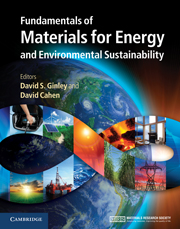Book contents
- Frontmatter
- Contents
- Contributors
- Preface
- Acknowledgments
- Part 1 Energy and the environment: the global landscape
- Part 2 Nonrenewable energy sources
- Part 3 Renewable energy sources
- Part 4 Transportation
- Part 5 Energy efficiency
- Part 6 Energy storage, high-penetration renewables, and grid stabilization
- 42 Toward the smart grid: the US as a case study
- 43 Consequences of high-penetration renewables
- 44 Electrochemical energy storage: batteries and capacitors
- 45 Mechanical energy storage: pumped hydro, CAES, flywheels
- 46 Fuel cells
- 47 Solar fuels
- 48 Solar thermal routes to fuel
- 49 Photoelectrochemistry and hybrid solar conversion
- Summary
- Appendix A Thermodynamics
- Appendix B Electrochemistry
- Appendix C Units
- Index
- References
49 - Photoelectrochemistry and hybrid solar conversion
from Part 6 - Energy storage, high-penetration renewables, and grid stabilization
Published online by Cambridge University Press: 05 June 2012
- Frontmatter
- Contents
- Contributors
- Preface
- Acknowledgments
- Part 1 Energy and the environment: the global landscape
- Part 2 Nonrenewable energy sources
- Part 3 Renewable energy sources
- Part 4 Transportation
- Part 5 Energy efficiency
- Part 6 Energy storage, high-penetration renewables, and grid stabilization
- 42 Toward the smart grid: the US as a case study
- 43 Consequences of high-penetration renewables
- 44 Electrochemical energy storage: batteries and capacitors
- 45 Mechanical energy storage: pumped hydro, CAES, flywheels
- 46 Fuel cells
- 47 Solar fuels
- 48 Solar thermal routes to fuel
- 49 Photoelectrochemistry and hybrid solar conversion
- Summary
- Appendix A Thermodynamics
- Appendix B Electrochemistry
- Appendix C Units
- Index
- References
Summary
Focus
Photoelectrochemistry studies photo-driven electrochemical processes (light-driven processes which interconvert electrical and chemical energy). As with photovoltaics, photoelectrochemical processes can directly convert sunlight into electricity, but have the additional capabilities of being able to store energy, as in solar batteries, or to directly convert solar energy to chemical energy, as in the production of hydrogen fuel or disinfectants. The challenges involved, which have impeded the development of photoelectrochemical devices, can include corrosion, lower solar-energy-conversion efficiency, and packaging vulnerabilities of liquid systems. (i) Dye-sensitized solar cells, (ii) STEP energetic chemical generation and (iii) photoelectrochemical waste treatment are technologies that address many of these challenges.
Synopsis
Society's electrical needs are largely continuous. However, clouds and darkness dictate that photovoltaic (PV) solar cells have an intermittent output. A photoelectrochemical solar cell (PEC) can generate not only electrical but also electrochemical energy, thereby providing the basis for a system with an energy-storage component. Sufficiently energetic insolation incident on semiconductors can drive electrochemical oxidation/reduction and generate chemical, electrical, or electrochemical energy. Aspects include efficient dye-sensitized or direct solar-to-electrical energy conversion, solar electrochemical synthesis (electrolysis), including the splitting of water to form hydrogen, the generation of solar fuels, environmental cleanup, and solar-energy-storage cells. The PEC utilizes light to carry out an electrochemical reaction, converting light to both chemical and electrical energy. This fundamental difference between the PV solar cell's solid/solid interface and the PEC's solid/liquid interface has several ramifications in cell function and application. Energetic constraints imposed by single-bandgap semiconductors have limited the demonstrated values of photoelectrochemical solar-to-electrical energy-conversion efficiency for and using multiple-bandgap tandem cells can lead to significantly higher conversion efficiencies. Photoelectrochemical systems not only may facilitate solar-to-electrical energy conversion, but also have led to investigations into the solar photoelectrochemical production of fuels, photoelectrochemical detoxification of pollutants, and efficient solar thermal electrochemical production (STEP) of metals, fuels, and bleach, and carbon capture.
- Type
- Chapter
- Information
- Publisher: Cambridge University PressPrint publication year: 2011



